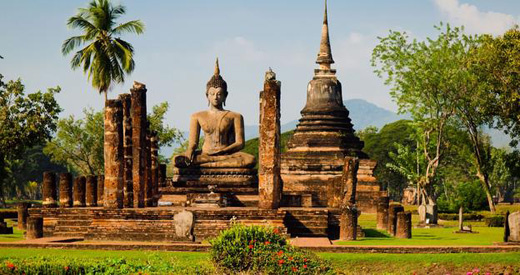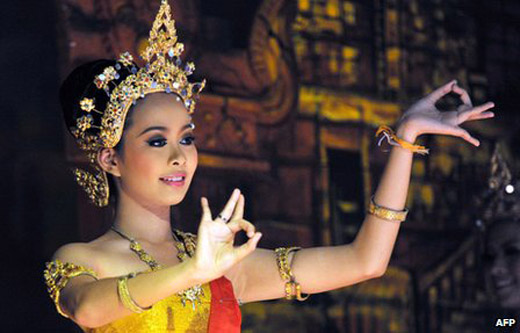|

History of Thailand
Thailand’s social history can be traced back to the Neolithic period
and has witnessed the rise and fall of a myriad of empires and
dynasties. Thailand, as we know it now, came into effect with the
establishment of an alliance between three kingdoms: Lan Na, Sukhothai,
and Phayao in the 13th century. The 14th and 15th centuries witnessed
the establishment of the kingdom of Ayutthaya, which continued until
it fell to the Burmese, initially in 1569, then again in 1760 before
finally falling again in 1767.
Thailand’s current Chakri Dynasty began in 1782 when Phraya Chakri
ascended the throne as King Ramathibodi, Rama I. The new dynasty moved
the country’s capital city to Bangkok where it remains to this day.
Current king Bhumibol Adulyadej, Rama IX, is the world’s longest
serving current head of state and Thailand’s longest reigning monarch,
having ascended to the throne in 1946.
King Mongkut, Rama IV, instigated trade and diplomatic relations with
European countries in the mid-19th century. He also instituted
educational reforms, developing a school system along European lines.
His son, King Chulalongkorn, Rama V, led Thailand into the 20th
century, establishing an effective civil service, formalising global
relations and introducing industrialisation. He united the royal line
under the title Rama and assigned the title Rama I to the dynasty's
first king.
During the reign of King Prajadhipok, Rama VII, Thailand changed from
an absolute monarchy to a constitutional monarchy following a
successful coup d’état in 1932. The country’s name was officially
changed from Siam to Prathet Thai, or Thailand, meaning "land of the
free" in 1939. The Thai use the phrase "land of the free" to express
pride in the fact that Thailand is the only country in Southeast Asia
never to be colonised by a European state.
The Thai military government sided with the Japanese forces in WW2 and
were involved in the construction of the infamous Burma-Siam railway,
made legend by the fictional British film Bridge Over The River Kwai.
The government also allowed US forces to use Thai territory during the
Vietnam War.
Democracy has developed slowly in Thailand with corruption
allegations, demonstrations and military coups derailing the process
on several occasions. After a quarter of a century of military rule,
civilian government was restored to Thailand in 1973 following student
riots in Bangkok, but this was to last only three years before the
military again took control. The country continues to move between
civilian and military governments.
On December 26 2004, an earthquake in Southeast Asia triggered a
tsunami that impacted considerably upon Thailand's touristic
infrastructure. The west coast was the worst hit area, including
outlying areas and tourist resorts near Phuket. Many hotels were
ruined; thousands were killed. Thailand has however made a strong
recovery from this terrible catastrophe and continues to be one of the
world’s top travel destinations.
Yingluck Shinawatra, Thailand’s first female Prime Minister assumed
office on August 5th 2011 following the 2011 general election. Leader
of the populist Pheu Thai Party, which replaced the controversial
People’s Power Party in 2008, her party won a majority with 265 of the
480 seats. She is the country's ninth leader in just over five years.
Thailand Culture

Religion:
The vast majority adhere to Buddhism (Theravada form), 5% are Muslim
and there are Christian and Hindu minorities.
Social conventions:
Western visitors will generally receive a handshake on meeting. A Thai
will be greeted with the traditional closed hands and a slight bow of
the head - the wai. Buddhist monks are always greeted in this way.
The Thai Royal Family is regarded with an almost religious reverence.
Visitors should respect this. It is very bad manners to make public
displays of anger, as Thais regard such behaviour as boorish and a
loss of 'face'. Public displays of affection between men and women are
also frowned upon, and it is considered rude to touch anyone on the
head or to point one's feet at someone. Shoes should be removed before
entering someone's home or a temple.
Informal dress is widely acceptable and men are seldom, if ever,
expected to wear suits. Beachwear should be confined to the beach and
topless sunbathing is frowned upon. Smoking is widely acceptable.

Language in Thailand
Thai is the official language. English is widely spoken, especially in
establishments catering for tourists.
Thailand’s social history can be traced back to the Neolithic period
and has witnessed the rise and fall of a myriad of empires and
dynasties. Thailand, as we know it now, came into effect with the
establishment of an alliance between three kingdoms: Lan Na, Sukhothai,
and Phayao in the 13th century. The 14th and 15th centuries witnessed
the establishment of the kingdom of Ayutthaya, which continued until
it fell to the Burmese, initially in 1569, then again in 1760 before
finally falling again in 1767.
Thailand’s current Chakri Dynasty began in 1782 when Phraya Chakri
ascended the throne as King Ramathibodi, Rama I. The new dynasty moved
the country’s capital city to Bangkok where it remains to this day.
Current king Bhumibol Adulyadej, Rama IX, is the world’s longest
serving current head of state and Thailand’s longest reigning monarch,
having ascended to the throne in 1946.
King Mongkut, Rama IV, instigated trade and diplomatic relations with
European countries in the mid-19th century. He also instituted
educational reforms, developing a school system along European lines.
His son, King Chulalongkorn, Rama V, led Thailand into the 20th
century, establishing an effective civil service, formalising global
relations and introducing industrialisation. He united the royal line
under the title Rama and assigned the title Rama I to the dynasty's
first king.
During the reign of King Prajadhipok, Rama VII, Thailand changed from
an absolute monarchy to a constitutional monarchy following a
successful coup d’état in 1932. The country’s name was officially
changed from Siam to Prathet Thai, or Thailand, meaning "land of the
free" in 1939. The Thai use the phrase "land of the free" to express
pride in the fact that Thailand is the only country in Southeast Asia
never to be colonised by a European state.
The Thai military government sided with the Japanese forces in WW2 and
were involved in the construction of the infamous Burma-Siam railway,
made legend by the fictional British film Bridge Over The River Kwai.
The government also allowed US forces to use Thai territory during the
Vietnam War.
Democracy has developed slowly in Thailand with corruption
allegations, demonstrations and military coups derailing the process
on several occasions. After a quarter of a century of military rule,
civilian government was restored to Thailand in 1973 following student
riots in Bangkok, but this was to last only three years before the
military again took control. The country continues to move between
civilian and military governments.
On December 26 2004, an earthquake in Southeast Asia triggered a
tsunami that impacted considerably upon Thailand's touristic
infrastructure. The west coast was the worst hit area, including
outlying areas and tourist resorts near Phuket. Many hotels were
ruined; thousands were killed. Thailand has however made a strong
recovery from this terrible catastrophe and continues to be one of the
world’s top travel destinations.
Yingluck Shinawatra, Thailand’s first female Prime Minister assumed
office on August 5th 2011 following the 2011 general election. Leader
of the populist Pheu Thai Party, which replaced the controversial
People’s Power Party in 2008, her party won a majority with 265 of the
480 seats. She is the country's ninth leader in just over five years.
Explore Thailand
 Why
Visit Thailand? Why
Visit Thailand?
 Thailand
Travel Guide Thailand
Travel Guide
 Traveling
to Thailand Traveling
to Thailand
 Thailand
things to see and do Thailand
things to see and do
 Thailand
Shopping and nightlife Thailand
Shopping and nightlife
 Thailand
Food and Drink Thailand
Food and Drink
 Getting
around Thailand Getting
around Thailand
 Bangkok
Travel Guide Bangkok
Travel Guide
 Chiang
Mai Travel Guide Chiang
Mai Travel Guide
 Ko
Lipe Travel Guide Ko
Lipe Travel Guide
 Koh
Phi Phi Travel Guide Koh
Phi Phi Travel Guide
 Ko
Phangan Travel Guide Ko
Phangan Travel Guide
 Phuket
Travel Guide Phuket
Travel Guide
 Thailand
History, Language and Culture Thailand
History, Language and Culture
 Thailand
Weather, climate and geography Thailand
Weather, climate and geography
 Thailand
Travel Tips Thailand
Travel Tips
 Thailand
Visa and Passport Requirements Thailand
Visa and Passport Requirements
 Thailand Satellite View & Map Thailand Satellite View & Map
 Thailand Visa Information Thailand Visa Information
 3 Destinations in 1 Ticket 3 Destinations in 1 Ticket
|
|